道康宁 732 硅酮胶 SDS
道康宁 导热胶

说明
性能
单组份;低流动性;灰色 单组份;低流动性;灰色 两组份;灰色;1:1 混合比率;中等粘度 两组份;灰色;1:1 混合比率
两组份;半流动性 单组份;灰色 单组份湿气固化粘合剂 单组份湿气固化粘合剂
单组份;灰色 流动性;单组份湿气固化粘合剂
单组份;不流动
两组份;半流动性
快速加热固化;高热传导性 快速加热固化;高热传导性 加热固化;良好的流动性 快速加热固化;较长的适用期;优异的流动 性;自粘合 较长的适用期;快速加热固化;自粘合 加热固化;中等热传导性;精炼型 可流动并具有中等的热传导性;快速表干 高粘度并具有中等的热传导性;UL 94V-1 等级;快速表干 加热固化;高热传导性 可流动并具有良好的热传导性,精炼型 (D4-D10 < 0.002);快速表干 室温固化;中等热传导性;UL 94 V-0 等 级;精炼型;快速表干 较长的适用期;快速加热固化;自粘合
热传导性,瓦特/米-K/平方厘米 磅/平方英寸 MPa 公斤力/平方厘米 延伸率,% 线性热膨胀系数 , 微米/米 摄氏度或百万分之一 伏特/密耳 千伏/毫米 介电常数在100 赫兹 介电常数在100 千赫兹 损耗因子在100 赫兹 损耗因子在100 千赫兹 体积电阻系数,欧姆-厘米 产品在室温下,由生产日期 起的保质期,月
热传导灌封胶
外观 流动性液体;固化成柔性弹性体
特性 恒定的固化速率,与灌封厚度或密封程度无关;无需 后固化
可考虑的应用范围 灌封高电压变压器及传感器;安装基材与散热器;作为热 源和散热器之间的间隙充填材料
热传导复合物 类别 不固化;热传导硅酮膏
特性 高热传导性;低渗油率;高温稳定性
可考虑的应用范围 热源和散热器之间的间隙充填材料
道康宁LED封装材料详细介绍

� �
适合SMD封装,可Molding成型 可作芯片保护
WE HELP YOU BOND THINGS TOGETHER
EG6301
�
�
� � �
EG6301是以有机硅为基材的双组分,无溶剂型,颜色透 明,高纯度,加热固化的半导体保护涂层. EG6301属普通折射率,高透光率,拥有低模量,能够与PPA 有良好的接着能力;A/B以1:1进行混合的,且以150 ℃加 热1小时使其固化成为橡胶状的胶体. 混合粘度 (at 25℃,mPa s):3000 折射指数(at 25℃,589nm):1.41 硬度 (Shore A):70
�
适合大功率填充
WE HELP YOU BOND THINGS TOGETHER
Q1-4939
�
�
� �
Q1-4939是以有机硅为基材的双组分,无溶剂型,颜 色透明,高纯度,加热固化的半导体保护涂层. Q1-4939属普通折射率,高透光率,拥有低模量,A/B 胶能够从10:1到1:1任意调配其配比;且以150 ℃ 加热1小时使其固化,具体的硬度随着主剂的减少而增 大. 混合粘度 (at 25℃,mPa s):5200(10:1) 折射指数(at 25℃,589nm):1.41
WE HELP YOU BOND THINGS TOGETHER
Side:3 Side:3
JCR6175
� �
� � �
JCR 6175 是以有机硅为基材的双组分,无溶剂型,颜色 透明,高纯度,加热固化的半导体保护涂层. JCR 6175具有很高的透射率,A与B以1:1的比例进行 混合,并且在150℃加热1个小时使之固化为柔软的弹性 体. 混合粘度 (at 25℃,mPa s):5500 折射指数(at 25℃,589nm):1.539 硬度 (Shore A):35
道康宁718硅酮密封胶说明书
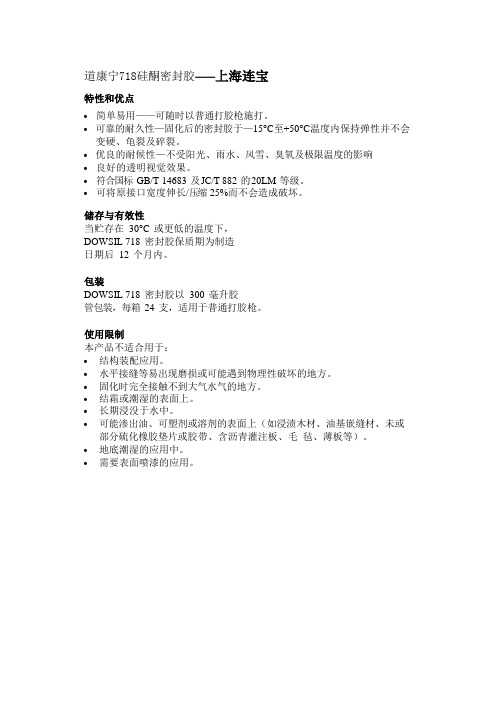
道康宁718硅酮密封胶——上海连宝
特性和优点
•简单易用——可随时以普通打胶枪施打。
•可靠的耐久性—固化后的密封胶于—15°C至+50°C温度内保持弹性并不会变硬、龟裂及碎裂。
•优良的耐候性—不受阳光、雨水、风雪、臭氧及极限温度的影响
•良好的透明视觉效果。
•符合国标GB/T 14683 及JC/T 882 的20LM 等级。
•可将原接口宽度伸长/压缩25%而不会造成破坏。
储存与有效性
当贮存在30°C 或更低的温度下,
DOWSIL 718 密封胶保质期为制造
日期后12 个月内。
包装
DOWSIL 718 密封胶以300 毫升胶
管包装,每箱24 支,适用于普通打胶枪。
使用限制
本产品不适合用于:
•结构装配应用。
•水平接缝等易出现磨损或可能遇到物理性破坏的地方。
•固化时完全接触不到大气水气的地方。
•结霜或潮湿的表面上。
•长期浸没于水中。
•可能渗出油、可塑剂或溶剂的表面上(如浸渍木材、油基嵌缝材、未或部分硫化橡胶垫片或胶带、含沥青灌注板、毛毡、薄板等)。
•地底潮湿的应用中。
•需要表面喷漆的应用。
硅酮胶安全技术说明书
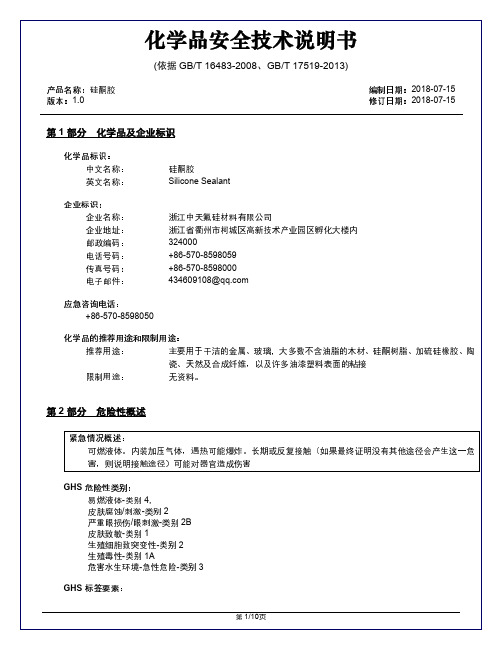
产品名称:硅酮胶版本:1.0编制日期:2018-07-15修订日期:2018-07-15第1部分化学品及企业标识化学品标识:中文名称:硅酮胶英文名称:Silicone Sealant企业标识:企业名称:浙江中天氟硅材料有限公司企业地址:浙江省衢州市柯城区高新技术产业园区孵化大楼内邮政编码:324000电话号码:+86-570-8598059传真号码:+86-570-8598000电子邮件:****************应急咨询电话:+86-570-8598050化学品的推荐用途和限制用途:推荐用途:主要用于干洁的金属、玻璃,大多数不含油脂的木材、硅酮树脂、加硫硅橡胶、陶瓷、天然及合成纤维,以及许多油漆塑料表面的粘接限制用途:无资料。
第2部分危险性概述紧急情况概述:可燃液体。
内装加压气体,遇热可能爆炸。
长期或反复接触(如果最终证明没有其他途径会产生这一危害,则说明接触途径)可能对器官造成伤害GHS危险性类别:易燃液体-类别4,皮肤腐蚀/刺激-类别2严重眼损伤/眼刺激-类别2B皮肤致敏-类别1生殖细胞致突变性-类别2生殖毒性-类别1A危害水生环境-急性危险-类别3GHS标签要素:产品名称:硅酮胶版本:1.0编制日期:2018-07-15修订日期:2018-07-15象形图:信号词:危险危险性说明:H227-可燃液体H315-造成皮肤刺激H320-造成眼刺激H317-可能造成皮肤过敏反应H341-怀疑可能造成遗传性缺陷H402-对水生生物有害防范说明:预防措施:P210-远离热源/火花/明火/热表面。
-禁止吸烟。
P280-戴防护手套/戴防护眼罩/戴防护面具P264-作业后彻底清洗P272-受沾染的工作服不得带出工作场地P260-避免吸入粉尘/烟气/气体/烟雾/蒸汽/喷雾。
P201-使用前获取特别指示P202-在读懂所有安全防范措施之前切勿搬动P273-避免释放到环境中事故响应:P370+P378-火灾时:使用干粉灭火器或泡沫灭火剂灭火P302+P352-如皮肤沾染:用大量肥皂和水清洗P333+P313-如发生皮肤刺激或皮疹:求医/就诊P305+P351+P338-如进入眼睛:用水小心冲洗几分钟。
732多功能密封胶清洗剂 MSDS
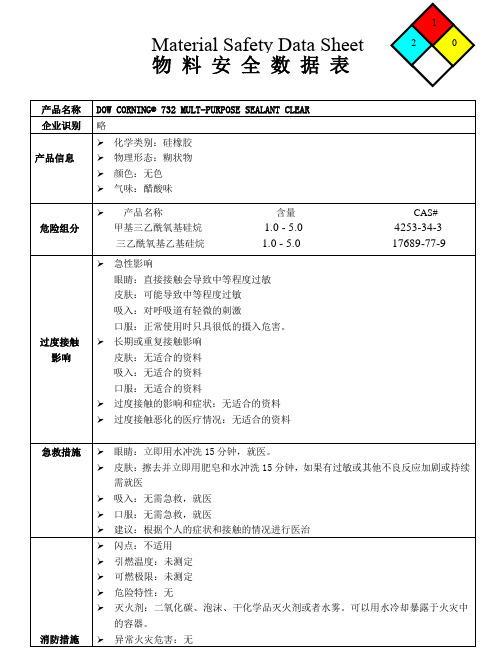
产品名称DOW CORNING® 732 MULT-PURPOSE SEALANT CLEAR 企业识别略产品信息➢化学类别:硅橡胶➢物理形态:糊状物➢颜色:无色➢气味:醋酸味危险组分➢产品名称含量CAS# 甲基三乙酰氧基硅烷 1.0 - 5.0 4253-34-3 三乙酰氧基乙基硅烷 1.0 - 5.0 17689-77-9过度接触影响➢急性影响眼睛:直接接触会导致中等程度过敏皮肤:可能导致中等程度过敏吸入:对呼吸道有轻微的刺激口服:正常使用时只具很低的摄入危害。
➢长期或重复接触影响皮肤:无适合的资料吸入:无适合的资料口服:无适合的资料➢过度接触的影响和症状:无适合的资料➢过度接触恶化的医疗情况:无适合的资料急救措施➢眼睛:立即用水冲洗15分钟,就医。
➢皮肤:擦去并立即用肥皂和水冲洗15分钟,如果有过敏或其他不良反应加剧或持续需就医➢吸入:无需急救,就医➢口服:无需急救,就医➢建议:根据个人的症状和接触的情况进行医治消防措施➢闪点:不适用➢引燃温度:未测定➢可燃极限:未测定➢危险特性:无➢灭火剂:二氧化碳、泡沫、干化学品灭火剂或者水雾。
可以用水冷却暴露于火灾中的容器。
➢异常火灾危害:无➢灭火程序:根据当地紧急计划,决定是否需要撤离或隔离该区域,用水冷却受火灾影响暴露的容器。
扑灭涉及化学物品的大火时,应佩戴自给式呼吸器及防护衣物。
➢有害的燃烧产物:二氧化碳及微量的未完全燃烧的碳化物、二氧化硅、金属氧化物、甲醛、氢气泄漏应急处理➢消除方法:抹去并铲起装入容器中,佩戴本MSDS中要求的PPE.有关法律规定可能适用于本物品的泄露与释放。
同样适用于用来清理泄露的材料物品。
需要确定较合适的法律。
操作处置与储存➢操作注意事项:使用充分的通风排气设备。
避免接触眼睛和皮肤。
➢储存注意事项:保持容器密封,远离水源。
接触控制与个人防护➢组分接触控制组分名称CAS甲基三乙酰氧基硅烷4253-34-3三乙酰氧基乙基硅烷17689-77-9产品接触水或者潮湿空气会产生醋酸,需提供充分的通风条件控制接触量在OSHA条例范围之内:时间加权平均浓度:10PPM,ACGIH 阈限值:10PPM,短时间接触容许浓度:15PPM。
道康宁灌封材料技术文档TDS

类型 弹性体
双组分有机硅弹性体
外观 双组分有机硅弹性体
特性 流动性液体;固化后形成柔性弹性体;固化速度 均匀,与灌封的厚度和环境的密闭程度无关;使 用温度在-45到 200°C(-49 到392°F);无需二次固 化;优良的绝缘性能;模量低,超级的应力释放 性能;易于再加工和修理。
潜在用途 在高湿、极端温度、热循环应力、机械冲击和振 动、霉菌、污垢等恶劣条下为电气/电子装置和 元器提供保护。
道康宁 ® SE 1740
无底漆有机硅灌封胶 道康宁 ® 3-8264无底漆有机硅 粘合剂
道康宁 ® 567无底漆有机硅灌 封胶
道康宁 ® 3-4207 介电柔韧凝 胶套装
潜在用途
普通灌封;电源供应器;连接 器;传感器;工业控制;变压 器;放大器;高压电阻器;太 阳能电池。
Sylgard® Q3-3600 A&B导 双组分,1:1混合,快速热固化,具有无底漆粘结 1:1混合比;长适用期;良好的流动性;无底
热灌封胶
能力和良好的阻燃性质。
漆;导热;UL V-1可燃性等级。
道康宁 ® S1混合,红棕色热固化灌封胶,精炼级 和良好的阻燃性质。
150°C (302°F)时需1小时
1以上这些数据是以样品量50-100克进行收集的,都非常具有代表性,因此可作为固化时间的初步估计。固化时间会随样品的不 同而有轻微的变化,也会由于您元器的大小和加热速度而变长或变短。建议您在使用前预先测试加以验证。 2对于无底漆粘合产品,其固化时间由达到所需硬度的时间来决定。固化时若需要完全的粘结性能需要更长的时间。
检查。在某些具体设计或应用条下,道康宁 ®
3-4207介电绝缘柔韧凝胶可能会丧失粘合力;建 议进行全环境暴露试验。
道康宁有机硅凝胶TDS

低温固化 超低温产品 道康宁® 品牌硅酮凝胶通常可以特别抵挡低于-45°C (-49°F) 的寒冷环境,对于更低温度时的使用,我们可提 供特殊的产品,其可用于低于-80°C (-112°F) 的超低温 环境。
坚固凝胶 坚韧/牢固凝胶 对于需要凝胶具有额外强度的应用,我们可提供坚韧或 牢固的凝胶产品。这些产品具有增强了的粘合性,但是 固化比标准凝胶略难。其中有些产品可允许快速室温固 化,另外有些产品还含有UV染色剂以方便检测。
低温凝胶
类型:单组分或两组分材料;提供不同的固化速度和硬度 物理形态:根据重量或体积以1:1混合比率混合(两组分材 料);单组分和两组分材料可以不同的未固化粘度提供。 特性:通过固化温度控制固化率;固化的凝胶具有很广的 操作温度范围 (-80至200°C/-112至392°F) 潜在用途:通过涂层、密封、埋嵌等密封和保护各类电子 仪器,特别是那些精细元件及需要暴露低温环境的应用。
比例不精确或搅拌混合不充分可能局部或普遍影响凝胶 特性或固化性能。如果可能,在设计部件及选择混合施 用凝胶过程中,应注意潜在的气体潜入及掺和(特别是 空气),其对高粘度和快速固化凝胶特别重要。应使用 >28英吋(10-20 mm) Hg 的真空泵抽出空气,以确保保护 层无空洞。
工作时间和固化 工作时间(适用期)是指在室温下使初始混合粘度加倍 时所需要的时间。对于两组分、加成固化产品,固化反 应自A部分和B部分混合开始,随着固化进程,粘度增 加直至形成柔软凝胶;对于单组分、加成固化和UV-固 化产品,粘度在室温下以极低速率增加或没有大的改 变。有关各产品的固化条件将在特性表中列出。固化的 定义是指特制凝胶达到90%完全特性所需要的时间,凝 胶在完全固化后达到不流动状态。 加成固化硅酮凝胶可 进行室温及加热固化或独特的高温固化,增加温度可以 加速固化反应。
道康宁DOW corning工业硅酮密封胶
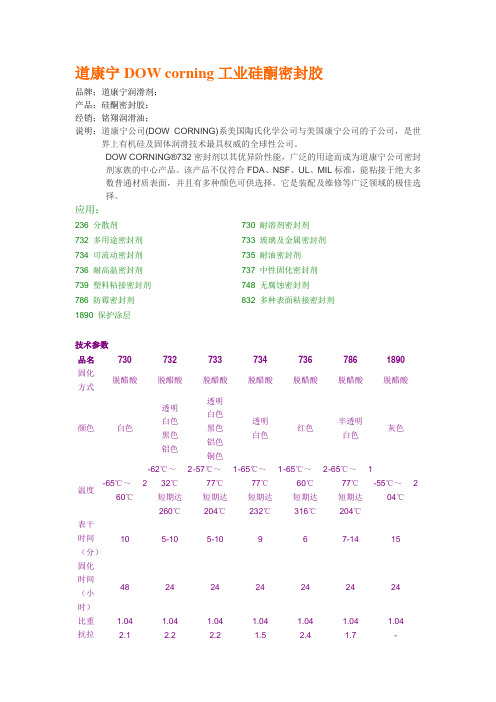
道康宁DOW corning工业硅酮密封胶品牌;道康宁润滑剂;产品;硅酮密封胶;经销;铭翔润滑油;说明;道康宁公司(DOW CORNING)系美国陶氏化学公司与美国康宁公司的子公司,是世界上有机硅及固体润滑技术最具权威的全球性公司。
DOW CORNING®732密封剂以其优异阶性能,广泛的用途而成为道康宁公司密封剂家族的中心产品。
该产品不仅符合FDA、NSF、UL、MIL标准,能粘接于绝大多数普通材质表面,并且有多种颜色可供选择。
它是装配及维修等广泛领域的极佳选择。
应用;236 分散剂730 耐溶剂密封剂732 多用途密封剂733 玻璃及金属密封剂734 可流动密封剂735 耐油密封剂736 耐高温密封剂737 中性固化密封剂739 塑料粘接密封剂748 无腐蚀密封剂786 防霉密封剂832 多种表面粘接密封剂1890 保护涂层技术参数品名7307327337347367861890固化方式脱醋酸脱醋酸脱醋酸脱醋酸脱醋酸脱醋酸脱醋酸颜色白色透明白色黑色铝色透明白色黑色铝色铜色透明白色红色半透明白色灰色温度-65℃~260℃-62℃~232℃短期达260℃-57℃~177℃短期达204℃-65℃~177℃短期达232℃-65℃~260℃短期达316℃-65℃~177℃短期达204℃-55℃~204℃表干时间(分)10 5-10 5-10 9 6 7-14 15 固化时间(小时)48 24 24 24 24 24 24比重 1.04 1.04 1.04 1.04 1.04 1.04 1.04 抗拉 2.1 2.2 2.2 1.5 2.4 1.7 -强度(MPa)硬度指数(肖氏,A)40 25 26 28 28 30 23伸长率(%)200 550 500 300 500 470 - 压出量(克/分)250 350 350 620 335 300 - 保质期(月)18 30 30 24 30 30 6包装90ml170ml17L90ml300ml20kg305ml17L90ml305ml17L305ml17L305ml4.55L20L标准-FDAUSDANSF51NSF61ULMILULFDANSF51ULMILFDAUSDANSF51ULMILFDANSF51MILFDA接上表品名236735737739748832固化方式脱肟脱肟脱肟脱醇脱醇脱醇颜色白色黑色透明白色黑色白色黑色白色白色灰色黑色温度-57℃~200℃-62℃~204℃短期达260℃-65℃~204℃短期达232℃-54℃~177℃-55℃~177℃短期达204℃-55℃~150℃表干时间(分)85 10 3-6 20-30 15 20 固化时间(小时)24 24 24 24 36 24 比重 1.64 1.06 1.04 1.50 1.34 1.34 抗拉强度(MPa)2.2 2.2 1.8 1.6 1.9 2.4 硬度指数(肖23 40 35 37 35 35氏,A)伸长率(%)350 300 430 640 350 550 压出量(克/分)- 300-450 440 110 180 165 保质期(月) 6 12 24 15 24 18包装453g90ml305ml17L90ml305ml17L90ml305ml17L90ml305ml17L305ml17L标准- - FDAULULFDANSF51ULUL常规产品应用说明:1.DOW CORNING 732为一种单组分室脱醋酸固化类型硅胶,由于其优异的耐极低、高温及密封性能,广泛应用于微波炉、洗碗机、电磁炉等家用电器及船舱与窗户以及电箱、重叠金属片的接口,装置输送槽,为压缩孔、齿轮箱、泵制造定位衬垫等。
[新版]中性硅酮密封胶msds
![[新版]中性硅酮密封胶msds](https://img.taocdn.com/s3/m/f9c56edcbb68a98270fefa15.png)
[新版]中性硅酮密封胶msds中性硅酮密封胶1物质组成/配方信息物质/混合物混合物组成重量百分比(Wt%,甲醇 65~75改性醋酸乙烯树脂,其他 25~35甲苯 #1合计 1002危险有害性分类分类联合国分类可燃性液体(3级)联合国编号 1992物理和化学危害可燃液体,剧毒物质,混入空气会有爆炸危险。
人体健康危害影响中枢神经系统,会导致头疼、恶心、呕吐和眩晕。
可能会失去知觉,严重时会导致失明。
3应急措施眼睛接触用清水冲洗眼球至少15分钟,然后立即前往眼科医生处就诊。
冲洗时应拨开眼睑使眼球尽可能多得用水冲洗。
皮肤接触立即脱去污染衣物,用肥皂和水清洗皮肤,然后马上前往医院就诊。
不当吸入立即转移至新鲜空气处,帮助患者平静并保持体温。
然后立即前往医院就诊。
不当食入用清水冲洗嘴部,然后立即前往医院就诊。
4消防措施消火剂:干粉、二氧化碳、泡沫消防措施相关危害性:无消防员防护:火势较小时,可使用干粉,二氧化碳气体和泡沫等;火势较大时,可使用粉末灭火器来阻断空气。
5意外泄露应急措施少量泄露:用干燥砂、土、锯末及抹布等吸收残液,然后置于密闭容器进行回收。
大量泄露:用土等搭建围堰防止泄露,然后转移到安全场所进行适当的处理。
6操作及保管操作, 避免靠近火源、静电、火星以及其他引火源, 防止泄露, 防止接触以及吸入,应穿戴必要的个人防护装置储存, 避免阳光直射并储存在阴凉处,远离火源及其他高温材料7暴露控制/个人防护控制参数:ACGIH TLV(1998) OSHA PEL(1998)甲醇 TWA 200ppm 200ppm甲苯 TWA 50ppm 50ppm设备对策:如在密闭环境使用该产品应设置机械排气系统,并在使用场所附近设置喷淋装置以及洗手、洗眼槽,并显著位置加以标识。
个人保护器具:呼吸保护:佩戴面罩防止有机毒气眼睛保护:戴防护眼镜手/皮肤/身体保护:穿戴防溶剂等的防护手套,如果必要亦可穿戴围裙,鞋子等。
请勿穿短袖衫工作。
道康宁产品应用技术手册
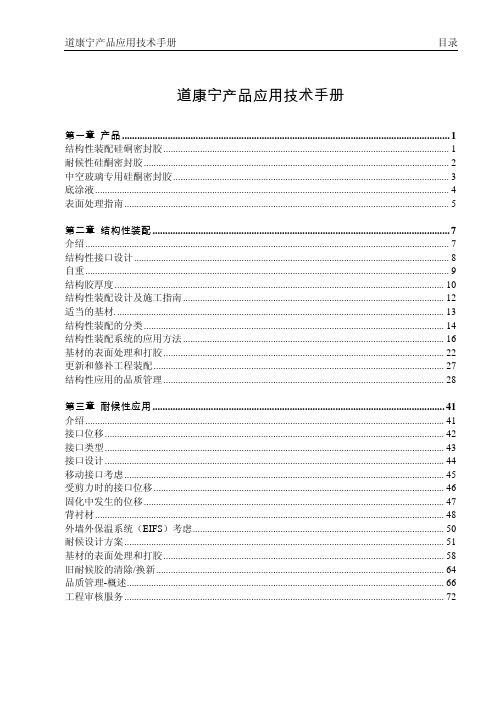
道康宁产品应用技术手册
介绍
介绍
本手册提供用户在结构性和耐候性系统中使用道康宁硅酮密封胶的质量保证程序。本手册所推 荐的程序是基于道康宁公司产品在工程项目中使用超过30年成功的经验。由于建筑工程的变化 因素很多,如设计,客户要求和环境因素等,本手册所提供的质量保证程序的内容无法涵盖 所有变化因素。
道康宁产品应用技术手册
描述 道康宁 993N结构性装配硅酮密封胶是双组分,中性固化的硅酮密封胶,用作玻璃、金属和 其它建筑元件的结构性粘结。道康宁 993N结构性装配硅酮密封胶固化形成高模量的弹性密 封胶,并对大部分的建筑材料都有优良的粘结性。主剂为白色,催化剂为黑色,混合后为黑 色。
第一章 产品
第一章 产品
道康宁具有配套齐全的高性能硅酮结构密封胶,这些密封胶可以根据其各自具有的独特性能 被用于不同的应用中。具体的产品数据信息例如物理性能、应用和限制等都能在产品数据表 中找到或登录公司网站查询。
结构性装配硅酮密封胶
道康宁 993N结构性装配硅酮密封胶
道康品 ................................................................................................................................. 1 结构性装配硅硐密封胶 ..................................................................................................................... 1 耐候性硅酮密封胶 ............................................................................................................................. 2 中空玻璃专用硅酮密封胶 ................................................................................................................. 3 底涂液 ................................................................................................................................................. 4 表面处理指南 ..................................................................................................................................... 5
道康宁732硅酮密封胶说明书

未被测试或陈述为适用于医用或药用。
道康宁732硅酮密封胶——上海连宝
特性和优点
单组分粘接剂/密封胶
当暴露在空气中水分时,在室温下就可以固化
脱酸固化体系
不垂流,膏状物
使用方便
固化后为韧性的弹性橡胶
对许多基材都有很好的粘接性
在-60°C(-76°F)到 180°C(356°F)之间保持稳定和弹性,
短时间可耐+205°C(401°F)高温
黑色:在-60°C(-76°F)到+205°C(401°F)之间保持稳定和弹性,
短时间可耐+230°C(446°F)高温
优良的绝缘性质
符合 MIL-A-46106 要求
符合 FDA 177.2600 要求
颜色为白色、黑色,透明和铝色
应用
作为一般的工业用密封与粘接应用
符合 MIL-A-46106 和 FDA 177.2600 要求
应用方法
基材处理所有表面都必须清洁干燥。除油并且洗掉所有可能影响粘接能力的
污染物, 适用的清洗溶剂包括:异丙醇、丙酮和甲乙酮。在许多基材,例如玻璃、金属和绝大多数的工程塑料上不用底涂都可以粘接,但是对通常粘结效果不好的材料如 PTFE、聚乙烯、聚丙烯和其它一些类
似的材料上要做底涂处理。如果要达到最佳的粘接效果,推荐使用 DOWSIL™
尤其是不容易接触到湿气的地方需要更长的时间才能固化完全,在湿度较低
时,固化时间会相对应延长。
在使用或包装粘接好的部件时,用户最好能等足够长的时间以确保粘接部分
固化完全,这与很多影响因素有关,用户应视具体情况而定。
相容性
DOWSIL™ 732 多用途密封剂在固化过程中会释放少量的醋酸,可能会腐蚀
道康宁硅胶资料电子版

SE4704U RC-4(50P) 0.60 170/10 200/4 1.11
40
95
650
20
3.6 17(150C/22hr)
SE4705U RC-4(50P) 0.60 170/10 200/4 1.11
50
95
450
20
3.7
8(150C/22hr)
SE4706U RC-4(50P) 0.60 170/10 200/4 1.11
60
80
280 20(JISB)
3.0 12(180C/22hr)
B6670 INT RC-4(50P) 0.45 170/10 200/4 1.34
70
60
280 18(JISB)
2.7 12(180C/22hr)
B6680 INT RC-4(50P) 0.40 170/10 200/4 1.34
80
95
140 18(JISB)
3.7 32(180C/22hr)
DY32-
RC-4(50P) 0.50 170/10 200/4 1.26
70
71
160
9
3.4
-
k-730
RC-4(50P) 1.00 170/10 200/4 1.11
30
80
700
13
3.8
-
k-740
RC-4(50P) 1.00 170/10 200/4 1.14
44
100
650
21
DY32-
RC-4(50P) 0.80 170/10 200/4 1.13
50
110
600
28
DY32-
RC-4(50P) 0.80 170/10 200/4 1.18
硅酮胶规格型号

硅酮胶规格型号
硅酮胶作为一种重要的密封材料,广泛应用于各种行业中。
不同的应用场景需要不同规格型号的硅酮胶。
常见的硅酮胶规格型号如下: 1. 一般硅酮胶:常用规格型号为100g/支、310ml/支、2600ml/桶等。
2. 食品级硅酮胶:常用规格型号为100g/支、310ml/支、2600ml/桶等。
3. 医用硅酮胶:常用规格型号为100g/支、310ml/支、2600ml/桶等。
4. 低温硅酮胶:常用规格型号为100g/支、310ml/支、2600ml/桶等。
5. 高温硅酮胶:常用规格型号为100g/支、310ml/支、2600ml/桶等。
6. 导电硅酮胶:常用规格型号为100g/支、310ml/支、2600ml/桶等。
7. 耐高压硅酮胶:常用规格型号为100g/支、310ml/支、2600ml/桶等。
8. 耐化学品硅酮胶:常用规格型号为100g/支、310ml/支、2600ml/桶等。
以上是硅酮胶常见的规格型号,不同厂家生产的硅酮胶规格型号可能会有所不同,用户在选择使用时需根据实际需要选购合适的规格型号产品。
道康宁732多用途密封胶
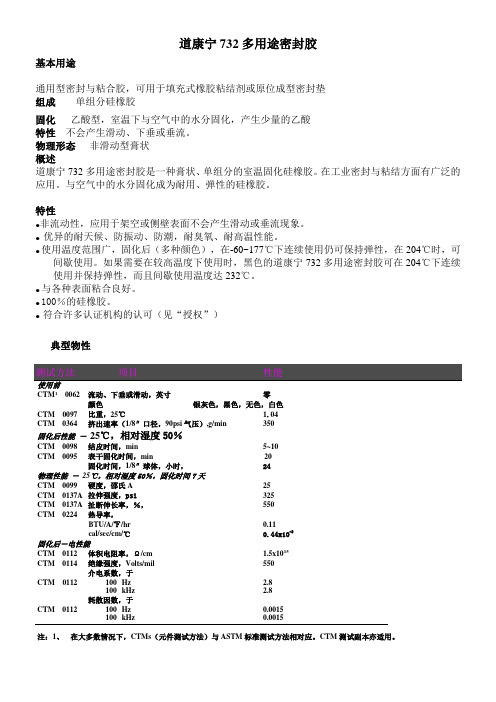
道康宁732多用途密封胶基本用途通用型密封与粘合胶,可用于填充式橡胶粘结剂或原位成型密封垫组成单组分硅橡胶固化乙酸型,室温下与空气中的水分固化,产生少量的乙酸特性不会产生滑动、下垂或垂流。
物理形态非滑动型膏状概述道康宁732多用途密封胶是一种膏状、单组分的室温固化硅橡胶。
在工业密封与粘结方面有广泛的应用。
与空气中的水分固化成为耐用、弹性的硅橡胶。
特性●非流动性,应用于架空或侧壁表面不会产生滑动或垂流现象。
●优异的耐天候、防振动、防潮,耐臭氧、耐高温性能。
●使用温度范围广,固化后(多种颜色),在-60~177℃下连续使用仍可保持弹性,在204℃时,可间歇使用。
如果需要在较高温度下使用时,黑色的道康宁732多用途密封胶可在204℃下连续使用并保持弹性,而且间歇使用温度达232℃。
●与各种表面粘合良好。
●100%的硅橡胶。
●符合许多认证机构的认可(见“授权”)典型物性CTM10062流动、下垂或滑动,英寸零颜色银灰色,黑色,无色,白色CTM 0097 比重,25℃1.04CTM 0364 挤出速率(1/8″口径,90psi气压),g/min 350固化后性能-25℃,相对湿度50%CTM 0098 结皮时间,min 5~10CTM 0095 表干固化时间,min 20固化时间,1/8″球体,小时,24物理性能-25℃,相对湿度50%,固化时间7天CTM 0099 硬度,邵氏A 25CTM 0137A 拉伸强度,psi 325CTM 0137A 扯断伸长率,%,550CTM 0224 热导率,BTU/A/℉/hr 0.11cal/sec/cm/℃0.44x10-3固化后-电性能CTM 0112 体积电阻率,Ω/cm 1.5x1015CTM 0114 绝缘强度,Volts/mil 550介电系数,于CTM 0112 100Hz 2.8100kHz 2.8耗散因数,于CTM 0112 100Hz 0.0015100kHz 0.0015注:1、在大多数情况下,CTMs(元件测试方法)与ASTM标准测试方法相对应。
道康宁732密封胶产品说明

DOWCORNING道康宁732密封胶包转规格:300ml/支道康宁732FDA单组分硅酮橡胶类型:单组分硅酮橡胶物理形状:粘稠膏状干结方法乙酰制剂:在室温下暴露在空气中的水蒸气中进行干结。
释放少量醋酸。
特性:不会松垂、下陷或脱离物体表面。
基本用途:进行一般的密封和粘结或作为空间填充的粘性橡胶或塑性填料。
说明:道康宁732多用密封胶是膏状、单组分硅酮RTV,适于进行多种工业密封和粘结用途。
它通过与空气中的水蒸气的反应,在室温下干结,生成耐久的、有弹性的硅酮橡胶。
道康宁732多用密封胶的特性包括:1.不会流动:可用于天棚或墙壁的表面,不会松垂或脱离。
2.对气候、振动、水分、臭氧和过高或过低温度有良好的适应性。
3.能适应的温度范围宽。
连续在-76到350华氏度(-60到177摄氏度)下使用或在高达400华氏度(204摄氏度)时间歇使用时,干结后的材料(对绝大多数颜色)能保持弹性。
当需要更高的温度性能时,道康宁732多用密封胶(黑色)能连续在400华氏度(204摄氏度)或间歇在高达450华氏度(232摄氏度)下保持弹性。
A.能粘结各种材料的表面。
B.百分之百硅酮橡胶。
C.DOWCORNING道康宁732密封胶符合多种规范的要求(参阅“认可”部分)。
典型特性:这些数值不准备使用在详细说明书中提供的CTM10062流动、松垂或下陷,英寸…………………………零颜色…………………………………………………银白、黑、透明、白CTM09777华氏度(25℃)时的比重………………………1.04CTM0364挤压率(1/8英寸的孔,90psi空气压力),克/分钟 (350)干结特性--暴露在77华氏度(25℃)和50%RH的空气中CTM098表层干结时间,分钟…………………………………5---10CTM095无粘性时间,分钟 (20)干结时间,1/8英寸小珠,小时 (24)使用方法道康宁732多用途密封胶可用于多种不同的密封和粘结用途.这个密封胶可用于:1.粘结汽车和家庭用具的装饰品。
硅酮胶生产配方

硅酮胶生产配方一、硅酮胶简介硅酮胶是一种以聚合物硅酮为主要成分的密封胶,因其具有良好的耐候性、耐腐蚀性、耐久性和无毒性等特点,被广泛应用于建筑、汽车、电子、航空航天等各个领域。
硅酮胶的粘附力强,可以对大多数材料进行粘接,并且在高温和低温下都能够保持较好的粘结性能。
二、硅酮胶生产配方硅酮胶的生产配方主要由以下几种成分组成:1.聚合物硅酮:聚合物硅酮是硅酮胶的主要成分,由二氯硅烷和甲基三氯硅烷等单体聚合而成。
根据聚合度、分子量和侧链基团的不同,聚合物硅酮的性能也有所不同。
2.填料:为了提高硅酮胶的硬度和抗拉强度等性能,通常会加入一些填料,如碳酸钙、白炭黑等。
3.固化剂:硅酮胶的固化反应主要是由有机锡催化剂引发的,常用的有机锡催化剂有二月桂酸二丁基锡和辛酸亚锡等。
4.增塑剂:增塑剂主要用于调节硅酮胶的柔韧性,常用的增塑剂有邻苯二甲酸二丁酯和磷酸三甲酚酯等。
5.颜料:为了使硅酮胶具有特定的颜色和外观,可以加入一些颜料,如炭黑、钛白粉等。
三、硅酮胶性能影响因素硅酮胶的性能受到多种因素的影响,其中主要因素有:1.聚合物硅酮的类型和分子量:聚合物硅酮的类型和分子量是影响硅酮胶性能的重要因素。
不同类型和分子量的聚合物硅酮会对硅酮胶的粘度、固化速度、粘结性能、耐温性能等产生影响。
2.填料种类和添加量:填料的种类和添加量也会影响硅酮胶的性能。
不同的填料对硅酮胶的硬度和抗拉强度等性能有不同的影响,同时填料的添加量也会影响硅酮胶的粘度和固化速度等。
3.固化剂类型和添加量:有机锡催化剂的类型和添加量是影响硅酮胶固化速度和性能的重要因素。
不同类型的有机锡催化剂对硅酮胶的固化速度和耐热性能等有不同的影响,同时催化剂的添加量也会影响硅酮胶的性能。
4.增塑剂类型和添加量:增塑剂的类型和添加量会影响硅酮胶的柔韧性和耐寒性能等。
不同类型的增塑剂对硅酮胶的性能有不同的影响,同时增塑剂的添加量也会影响硅酮胶的性能。
5.生产工艺:生产工艺也是影响硅酮胶性能的重要因素。
硅酮胶主要原材料

硅酮胶主要原材料硅酮胶是一种高分子化合物,由多种原材料混合而成。
下面,我们将介绍硅酮胶的主要原材料及其性质和用途。
1. 硅烷单体硅烷单体是硅酮胶的主要原材料,它们的通用式为RnSiX4-n,其中R代表有机基团,X代表氢、氯、甲氧基等官能团,n的取值范围为1-3。
硅烷单体通过水解聚合反应,形成三维交联结构的硅酮胶。
硅烷单体的种类很多,例如甲基三苯基硅烷、环氧基甲基三苯基硅烷、甲基三乙氧基硅烷等。
它们的不同官能团和有机基团可以调节硅酮胶的化学和物理性质,提高其耐热、耐寒、耐化学腐蚀等性能。
2. 催化剂催化剂是硅烷单体水解聚合的重要组成部分,用于促进硅烷单体的酸碱催化反应。
常用的催化剂有稀酸、碱、金属盐等。
硅酮胶的催化剂选择应根据不同的硅烷单体种类和需要的性能加以调整。
例如,硅烷单体中含有氨基官能团时,应选用碱催化剂,以避免酸催化剂引起的副反应。
3. 填充剂填充剂可以增加硅酮胶的协同效应,提高其物理机械性能和化学稳定性。
常见的填充剂有二氧化硅、硅酸钙、氧化铝等。
填充剂的选择应根据硅酮胶的应用情况和需求来决定。
例如,对于高温环境或耐火材料,可以选择氧化铝或其他金属氧化物作为填充剂。
4. 添加剂添加剂是指用于改变硅酮胶性能或调节硅酮胶性能的化学物质。
常见的添加剂有添加剂、润滑剂、抗氧化剂等。
添加剂的选择应根据硅酮胶的应用环境和使用要求来确定。
例如,对于在潮湿环境中使用的硅酮胶,可以添加抗水剂和脱模剂,以防止水汽进入硅酮胶内部导致失效。
总之,硅酮胶的主要原材料包括硅烷单体、催化剂、填充剂和添加剂。
它们的不同种类和比例加以搭配,可以得到不同配方的硅酮胶,用于不同的领域和应用。
- 1、下载文档前请自行甄别文档内容的完整性,平台不提供额外的编辑、内容补充、找答案等附加服务。
- 2、"仅部分预览"的文档,不可在线预览部分如存在完整性等问题,可反馈申请退款(可完整预览的文档不适用该条件!)。
- 3、如文档侵犯您的权益,请联系客服反馈,我们会尽快为您处理(人工客服工作时间:9:00-18:30)。
Note: See section 8 for Personal Protective Equipment for Spills. Call Dow Corning Corporation, (989) 496-5900, if additional information is required. 7. HANDLING AND STORAGE Use with adequate ventilation. Product evolves acetic acid (HOAc) when exposed to water or humid air. Provide ventilation during use to control HOAc within exposure guidelines or use respiratory protection. Avoid eye contact. Avoid skin contact. Use reasonable care and store away from oxidizing materials. Keep container closed and store away from water or moisture. 8. EXPOSURE CONTROLS / PERSONAL PROTECTION Component Exposure Limits CAS Number 17689-77-9 4253-34-3 Component Name Ethyltriacetoxysilane Methyltriacetoxysilane Exposure Limits See acetic acid comments. See acetic acid comments.
Acetic acid is formed upon contact with water or humid air. Provide adequate ventilation to control exposures within guidelines of OSHA PEL: TWA 10 ppm and ACGIH TLV: TWA 10 ppm, STEL 15 ppm. Engineering Controls Local Ventilation: General Ventilation: Recommended. Recommended.
NFPA Profile: Health
Note: NFPA = National Fire Protection Association
1 Instability/Reactivity
0
2. OSHA HAZARDOUS COMPONENTS CAS Number 17689-77-9 4253-34-3 Wt % 1.0 - 5.0 1.0 - 5.0 Component Name Ethyltriacetoxysilane Methyltriacetoxysilane
Commercial Food Equipment Service Association
P_0000023950
D_0000028302
DOW CORNING CORPORATION Material Safety Data Sheet
Page: 3 of 7
SILASTIC 732(R) RTV ADHESIVE SEALANT, CLEAR
Commercial Food Equipment Service Association
P_0000023950
D_0000028302
DOW CORNING CORPORATION Material Safety Data Sheet
Page: 1 of 7
SILASTIC 732(R) RTV ADHESIVE SEALANT, CLEAR
The above components are hazardous as defined in 29 CFR 1910.1200. 3. EFFECTS OF OVEREXPOSURE Acute Effects Eye: Skin: Inhalation: Oral: Direct contact may cause moderate irritation. May cause moderate irritation. Irritates respiratory passages very slightly. Low ingestion hazard in normal use.
1. IDENTIFICATION OF THE SUBSTANCE AND OF THE COMPANY Dow Corning Corporation South Saginaw Road Midland, Michigan 48686 24 Hour Emergency Telephone: Customer Service: Product Disposal Information: CHEMTREC: (989) 496-5900 (989) 496-6000 (989) 496-6315 (800) 424-9300
4. FIRST AID MEASURES Eye: Skin: Immediately flush with water for 15 minutes. Get medical attention. Remove from skin and wash thoroughly with soap and water or waterless cleanser. Get medical attention if irritation or other ill effects develop or persist. No first aid should be needed. No first aid should be needed. Treat according to person's condition and specifics of exposure.
Inhalation: Oral: Comments:
5. FIRE FIGHTING MEASURES Flash Point: Autoignition Temperature: Not applicable. Not determined.
Flammability Limits in Air: Not determined. Extinguishing Media: On large fires use dry chemical, foam or water spray. On small fires use carbon dioxide (CO2), dry chemical or water spray. Water can be used to cool fire exposed containers. Self-contained breathing apparatus and protective clothing should be worn in fighting large fires involving chemicals. Determine the need to evacuate or isolate the area according to your local emergency plan. Use water spray to keep fire exposed containers cool. None.
The above listed potential effects of overexposure are based on actual data, results of studies performed upon similar compositions, component data and/or expert review of the product. Please refer to Section 11 for the detailed toxicology information.
P_0000023950
D_0000028302
DOW CORNING CORPORATION Material Safety Data Sheet
Page: 2 of 7
SILASTIC 732(R) RTV ADHESIVE SEALANT, CLEAR
No known applicable information.
Signs and Symptoms of Overexposure No known applicable information. Medical Conditions Aggravated by Exposure
Commercial Food Equipment Service Association
Prolonged/Repeated Exposure Effects Skin: Inhalation: Oral: No known applicable information. No known applicable information. No known applicable information.
Containment/Clean up: Observe all personal protection equipment recommendations described in Sections 5 and 8. Wipe up or scrape up and contain for salvage or disposal. Clean area as appropriate since some silicone materials, even in small quantities, may present a slip hazard. Final cleaning may require use of steam, solvents or detergents. Dispose of saturated absorbant or cleaning materials appropriately, since spontaneous heating may occur. Local, state and federal laws and regulations may apply to releases and disposal of this material, as well as those materials and items employed in the cleanup of releases. You will need to determine which federal, state and local laws and regulations are applicable. Sections 13 and 15 of this MSDS provide information regarding certain federal and state requirements.
